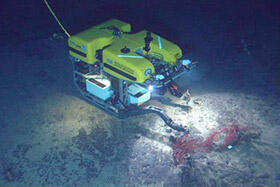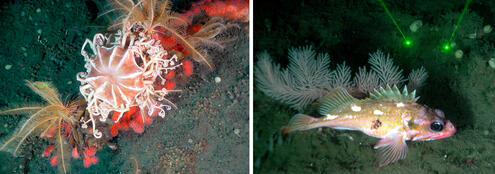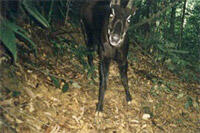Marine ecologist Kate Holmes answers this question:
Hi Margaret,
There are still some places on Earth that have not been explored much by people.
The ocean is one of these places. It covers more than 70% of Earth's surface, and it contains many types of ecosystems. We know a lot about some of these ecosystems, like the mangrove and kelp forests that surround our coastlines, and the polar seas at the North and South Poles. But we still have much to learn about remote and mysterious places like the deep sea .
The technology we use to explore the ocean continues to get better and better. People can now send robotic Remotely Operated Vehicles (ROVs) to dive deep into the ocean. Scientists operate the "robot" from a ship on the ocean surface. At the seafloor , the ROV can take pictures and videos, and even use a robotic arm to collect water and rock samples.

A Remotely Operated Vehicle (ROV) explores the seafloor.
The ROV brings back valuable information that scientists can use to help protect and conserve marine organisms and habitats . For example, in 2006, scientists sent an ROV deep into the Pacific Ocean off the coast of Washington State. They were able to learn more about deep-sea corals and sponges that can be easily damaged by commercial fishing equipment.

An ROV took these pictures of deep-sea corals and fish.
Unlike the oceans, almost every place on land has been visited by people. By using new technology, scientists can now learn more about remote places that are difficult for us to travel to, such as areas that are very cold, very wet, very dry, or very high.
In some of these places, scientists are also discovering new species! For example, in 1992, a new mammal species called the saola was discovered in the thick forests of Vietnam. (And some new species are even found in familiar places. In 2002, researchers found a new species of centipede living in the leaf litter in Central Park, New York City.)
As we document and learn about plant and animal species around the world, we can help understand how they live and how we can best protect them.

This saola photo was taken by a camera trap. No scientist has seen a saola in the wild!
You Can Make a Difference!
- How can you Be and Ocean Helper? Find out!
- Discover How to Help Biodiversity with this checklist.
Explore More:
- Dive Intro Worlds Within the Sea to explore different marine ecosystems.
- Play the Journey to the Bottom of the Sea game to find out how life survives in the ocean.
- Hop on the Alvin and Journey to Deep Sea Vents.




 Biodiversity
Biodiversity
 Brain
Brain
 Genetics
Genetics
 Marine BiOLogy
Marine BiOLogy
 MicrobiOLogy
MicrobiOLogy
 PaleontOLogy
PaleontOLogy
 ZoOLogy
ZoOLogy
 AnthropOLogy
AnthropOLogy
 ArchaeOLogy
ArchaeOLogy
 Astronomy
Astronomy
 Climate Change
Climate Change
 Earth
Earth
 Physics
Physics
 Water
Water


